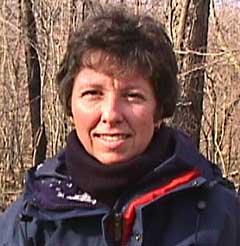 |
TRAINING FOR LIFE by Sue Carter NOTE: Click here for a sample training log you can print out and use for youself.TrainingPhysical fitness is a journey, not merely a destination. Every mile run, every pound pressed, every lap completed may lead to a goal, but it has another benefit - the joy of being in play and living in the moment. Getting ready to ski nearly 100 miles to the North Pole has taken a lot of hard work. It has been a journey with a destination. And a trip that started several years ago. Our first discussions about a trek to the North Pole began in late 1993, nearly eight years ago! During that time, the team acquired new members with varying levels of fitness, but all dedicated to the goal of reaching the North Pole under our own power. Each woman has designed her own program knowing the tough requirements needed to make a two-week trek. Let me share with you what my fitness journey has been like. Seven Years AgoTo ski to the North Pole, one needs to be a pretty good skier, or at least comfortable on skis, right? I tried out for, and was accepted as a candidate for the Mt Brighton Ski Patrol in Brighton, Michigan, not far from where I live. Though it's an alpine (downhill) ski area, and the Arctic is essentially flat, it taught me to be comfortable on skis carrying weight (my patrol belt). I also learned first responder skills to help with medical emergencies. My other activities that year included cross-country skiing, swimming, running, kayaking, biking, and a triathlon. Five Years AgoA typical week in January of 1996 included 10-12 hours of downhill skiing, eight miles running, and teaching water aerobics at the local YMCA. By summer, the Rollerblades had replaced the downhill skis and the runs were more frequent and longer. Foot surgery (on both feet - ouch) slowed me up in September and October, but I was swimming and walking in late fall, and back skiing in November and December. One Year AgoBy the beginning of 2000, cross-country skiing was also a part of my training. A nordic (cross-country) patrol needed volunteers and I skied Saturdays with them when La Nina didn't take away our snow. A year ago, my weekly activities included downhill skiing at Mt. Brighton, cross-country skiing when possible, weight training (free weights and machines) and those dreaded sit-ups. Knowing that a trek to the North Pole requires both strength and endurance, I've tried to concentrate on those two areas. 2001There's nothing like the pressure of a countdown to get one moving. Since the beginning of this year, I've focused on endurance and strength in some realistic ways. In January, the team met in Michigan's Upper Peninsula for a week of skiing and camping. We spent five nights in tents in near-zero temperatures, and skied trails, along the shore of Lake Superior, and at night! All the while, we had our backpacks and sleds filled with food, fuel, equipment and sleeping gear. In February I took a week and set up a training camp for myself in the West Virginia mountains. There wasn't the hoped-for snow, but each day was a 15-20 mile hike with a backpack filled with 25 points of potatoes. Most hikes lasted three hours, though the last day there was snow, and the hike extended to nearly six hours. In early March, Frida Waara and I went with several others on a three-day, two-night ski and camp trek in the Upper Peninsula where some of the snow was three feet deep. (Click here to view the Photo Gallery of our training.) Each day's skiing amounted to about eight miles distance. Getting and Staying FitThere is no one program that is good for everyone. Fitness depends on the person's ability, interest, and goals. The best fitness plan is one that is enjoyable and not a burden. For me, it all began with running in July 1980. I liked it, and started to read running and fitness, ran more, found races, and buddies. That activity has led me to run more than five thousand miles, twice the distance across the United States. Running also led me to other activities, and the belief that I could challenge myself and accomplish some difficult physical feats, like skiing to the North Pole. Just a final thought. Keeping a daily log has been very helpful for me. At the end of each day, I can write into that day's space my activity. Not every day is filled, but many are. It was exciting to be able to mark the run, swim, ski, or cycling of the day. It also gives me a look-back, now a decade, of my physical fitness. We've drawn up a sample fitness log for you. Have fun filling it, and enjoy the journey - and goal - of fitness. etting ready for a challenge such as cross-country skiing to the North Pole requires understanding the physical, psychological and emotional stresses of the trip. Younger people typically benefit from having strong bodies and energy reserves that can help them deal with the physical stresses of the trip. Older trekkers may have the edge in skills and experience. And all will need the fuel of good nutrition to make the trip. In this section, we will learn how Sue Carter of WomenQuest has trained for the trip, as well as what kinds of food the trekkers will eat and how it will be prepared on the trail. return to Exploration home page | |||||
|
|
||||||